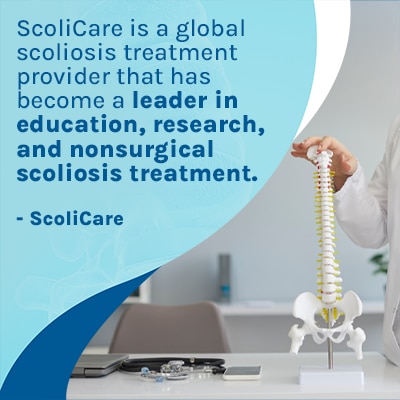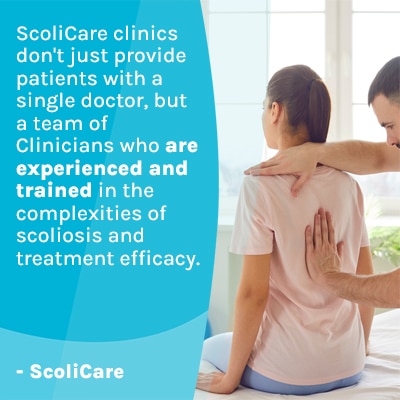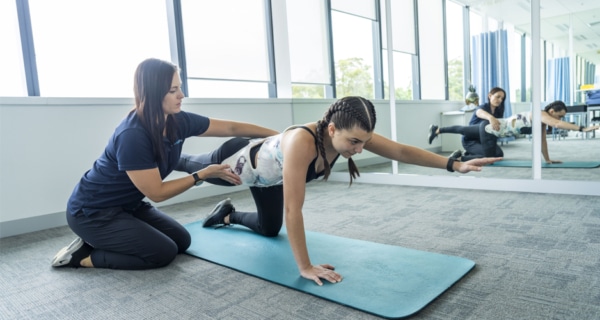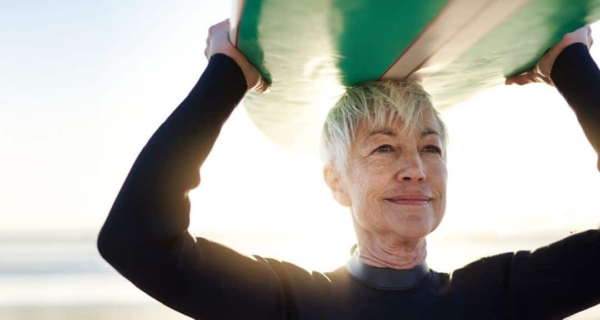Being diagnosed with a progressive spinal condition can feel overwhelming, and this is the time for patients, and their families, to make sure they’re fully informed about scoliosis and the different types of treatment available.
Following a scoliosis diagnosis, patients need to choose a treatment approach that addresses their expectations and needs. ScoliCare Centers are patient-focused and offer proactive nonsurgical treatment options. Finding the right scoliosis doctor and care team can shape a patient’s scoliosis journey and treatment outcome.
Scoliosis patients need to trust their care team; they need to be comfortable enough to ask questions, express concerns, and trust in their ability to achieve positive treatment results.
Being Diagnosed with Scoliosis
Being diagnosed with scoliosis can be overwhelming, and it’s natural for patients, and their families, to need guidance.
While scoliosis is a progressive lateral curvature of the spine, with rotation (1), it can be highly treatable, especially when the right treatment provider is involved, and while there are a number of different treatment centers and providers, quality can vary.
Being diagnosed with scoliosis means action needs to be taken. As a progressive condition, a diagnosis of mild scoliosis doesn’t mean it will stay mild, or that there is more time to act; mild scoliosis can become moderate scoliosis and/or severe scoliosis is left untreated (1).
And as progression is triggered by growth, early diagnosis and intervention can be particularly beneficial in childhood scoliosis treatment, and adolescent idiopathic scoliosis is the most prevalent type of scoliosis (2).
Scoliosis can be complex to treat, not just because it ranges from mild to severe, but also because there are multiple types of scoliosis with different causes, symptoms, and treatment needs, and this level of variance necessitates the experience of a scoliosis specialist (1).
Different types include idiopathic scoliosis, neuromuscular scoliosis, degenerative scoliosis, and congenital scoliosis.
So following a diagnosis, patients have an important decision to make: how to respond with treatment.
The ScoliCare Approach
 ScoliCare is a global scoliosis treatment provider that has become a leader in education, research, and innovative nonsurgical scoliosis treatment.
ScoliCare is a global scoliosis treatment provider that has become a leader in education, research, and innovative nonsurgical scoliosis treatment.
ScoliCare’s approach is evidence-based and has the goal of helping patients find the right doctor for personalized care with the potential to restore the spine/body’s balance and stability and trunk muscle endurance (3).
As our specialty is the nonsurgical management of scoliosis, an additional treatment goal is helping patients avoid the risks associated with scoliosis surgery.
A patient’s initial assessment/diagnosis is key to treatment success. The more accurate and comprehensive they are, the more customized treatment plans can be, and the more precise, and successful, treatment plans may be.
The ScoliCare approach is about aligning patients with the right treatment plan, which is why ScoliCare clinics are world-wide and can offer scoliosis assessment and management tools, innovative 3D body scanning technology, the world’s most advanced corrective scoliosis brace, and a proven customized scoliosis-specific exercise program.
ScoliCare clinics don’t just offer patients a single doctor, but a team of Clinicians who are experienced and trained in the complexities of scoliosis and treatment efficacy.
So why choose ScoliCare?
For a patient-centered individualized approach
For a comprehensive assessment and diagnosis
For evidence-based treatment
For the world’s most advanced scoliosis brace with 3D corrective potential
For an individualized exercise-based program with 3D corrective potential
For an effective alternative to spinal fusion
For the accessibility of world-class clinics that are world-wide
For a treatment approach that follows current SOSORT (Society of Scoliosis Orthopaedic and Rehabilitation Treatment) guidelines
For the types of positive patient outcomes ScoliCare is known for
As we’ve discussed what ScoliCare Clinics can offer, let’s explore the actual treatment process.
ScoliCare Treatment
As such a prevalent spinal condition, there is a lot of information circulating about scoliosis and scoliosis treatment; this can make it difficult for patients to navigate as they try to inform themselves.
ScoliCare is all about empowerment through information. We want our patients to be informed. We want them to ask questions. More importantly, our Clinicians are constantly asking patients questions to ensure their needs, concerns, and expectations are being addressed.
Treatment that promises big results shouldn’t be trusted; no results can ever be guaranteed, and as a complex condition, scoliosis isn’t always simple to treat.
Treatment plans that involve a single treatment discipline are likely to be limited in their potential efficacy because scoliosis needs to be impacted on multiple levels: the benefit of an integrative approach that combines different types of treatment.
In addition, a treatment plan with only one form of treatment can’t be adjusted and customized with the same precision that a multifaceted treatment approach can offer.
ScoliCare treatment integrates custom 3D bracing and scoliosis-specific exercise that can be apportioned accordingly based on each individual patient’s scoliosis and how they respond to treatment.
ScoliBrace
ScoliBrace® is an over-corrective, Mirror-Image® brace that’s become known as the world’s most advanced scoliosis brace.
While there are a number of traditional scoliosis braces available to patients on the path of traditional scoliosis treatment, ScoliCare Clinicians recognized a need for a different type of brace, and the ScoliBrace® emerged as a revolutionary alternative to traditional bracing.
The ScoliBrace® took the best of what traditional bracing had to offer and combined the most current research on bracing efficacy, spinal coupling, and 3D curvature correction (3).
As mentioned earlier, because of the rotation component, scoliosis is 3-dimensional, and while traditional bracing focuses on improving the scoliosis in two dimensions, the ScoliBrace® targets the curve and its rotation.
ScoliBrace® uses the technique of spinal coupling versus spinal immobilization, and as the spine’s natural design is movement-based, this has a number of benefits.
Allowing for movement during brace wear helps maintain spinal flexibility and muscle strength; the spine needs to be surrounded by strong and balanced muscles for support and stability.
So while typical treatment programs involving traditional bracing tend to focus on 2-dimensional treatment results, the potential benefits of the corrective ScoliBrace® can include a spine that’s straighter, more flexible, and may offer more-positive patient outcomes.
A primary benefit of the ScoliBrace® is because it’s designed to facilitate movement, it can be combined with a powerful scoliosis-specific exercise program to further reduce the scoliosis, increase spinal flexibility, improve posture, and restore the spine’s balance and alignment (3).
ScoliBalance
ScoliBalance® is an exercise-based scoliosis treatment program that’s customized, evidence-based, and effective (3).
When scoliosis treatment increases spinal flexibility, it makes the spine more responsive to all facets of treatment, so bracing and physical therapy designed by a spine specialist can work together.
ScoliBalance® empowers patients with awareness. Largely through the use of Mirror Image® exercises, patients are taught postural awareness, and knowing how to hold their spine and body during movement and daily activities is important for facilitating sustainable treatment results.
Following SOSORT guidelines (1), ScoliBalance® works towards restoring balance to the spine as a complete treatment program; it combines the potential benefits of physical therapy, chiropractic, and exercise rehabilitation for 3D correction.
ScoliBalance® Clinicians are trained and certified in the program, and customize treatment plans based on a patient’s curve severity, type, posture, and spinal function.
Patients are taught how to maintain optimal spinal alignment through posture and body positioning, and this level of postural restoration is necessary for sustainable treatment results.
So why choose ScoliBalance®?
To slow/stop progression
To maintain spinal flexibility
To improve the spine’s surrounding muscle balance
To improve the spine’s surrounding muscle strength for more spinal support and stability
To reduce pain
To complement the ScoliBrace ®
To restore balance to the spine and body, reducing the risk of injury through a fall in adult scoliosis.
While there are no treatment guarantees, an unnatural spinal curvature should be taken seriously, and the sooner nonsurgical methods are applied, the more effective they may be.
Conclusion
If you’re looking for a scoliosis doctor near you, there are over 200 ScoliCare Clinics around the world, and finding your nearest clinic can be the first step on the path of treatment success.
ScoliCare Clinicians are highly experienced specialists who focus on standard-setting patient management and care.
While some atypical and/or severe cases of scoliosis can receive surgical recommendations, many scoliosis cases are highly responsive to non surgical methods that are more aligned with the spine’s natural strength, function, and movement-based design.
Being proactive with treatment is the best way to counteract rapid progression, and this is a challenge of addressing the condition’s most-prevalent type: adolescent idiopathic scoliosis.
All patients need and deserve quality care, and ScoliCare Clinics have been providing children, adolescents, and adults with customized treatment plans for addressing scoliosis of all types and severity levels.
References:
- Negrini S, Donzelli S, Aulisa AG, Czaprowski D, Schreiber S, de Mauroy JC, Diers H, Grivas TB, Knott P, Kotwicki T, Lebel A, Marti C, Maruyama T, O’Brien J, Price N, Parent E, Rigo M, Romano M, Stikeleather L, Wynne J, Zaina F. 2016 SOSORT guidelines: orthopaedic and rehabilitation treatment of idiopathic scoliosis during growth. Scoliosis Spinal Disord. 2018 Jan 10;13:3. doi: 10.1186/s13013-017-0145-8. PMID: 29435499; PMCID: PMC5795289.
- Weinstein SL. The Natural History of Adolescent Idiopathic Scoliosis. J Pediatr Orthop. 2019 Jul;39(Issue 6, Supplement 1 Suppl 1):S44-S46. doi: 10.1097/BPO.0000000000001350. PMID: 31169647.
- Marchese R, Du Plessis J, Pooke T, McAviney J. The Improvement of Trunk Muscle Endurance in Adolescents with Idiopathic Scoliosis Treated with ScoliBrace® and the ScoliBalance® Exercise Approach. J Clin Med. 2024 Jan 23;13(3):653. doi: 10.3390/jcm13030653. PMID: 38337346; PMCID: PMC10856658.
The post Find Top Scoliosis Doctors Near Me | Effective Treatment appeared first on ScoliCare.


